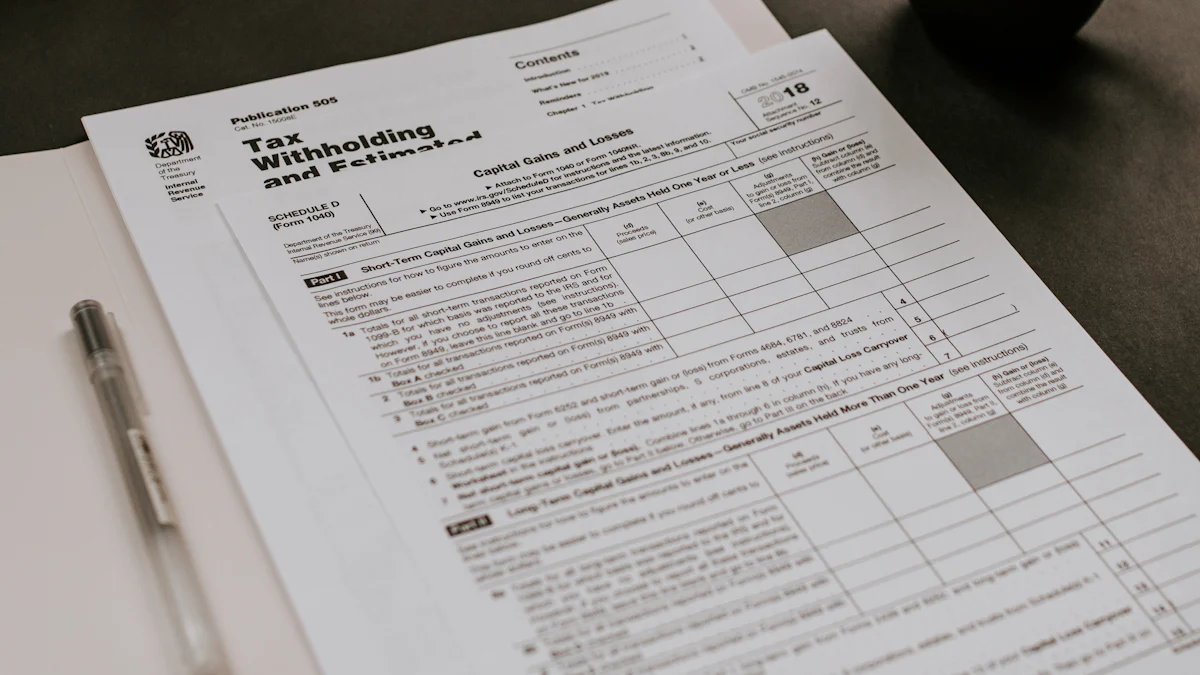Cracking the Code: Understanding IRS Offer In Compromise

Understanding the IRS Offer in Compromise (OIC) is crucial for individuals burdened with tax debt. This blog aims to Deciphering The Cryptic Criteria For An IRS Offer In Compromise, shedding light on its significance for taxpayers facing financial challenges. By delving into the intricacies of this IRS program, readers will gain valuable insights into navigating tax debts effectively. Let's embark on a journey through the nuances of OIC criteria and eligibility requirements to empower individuals seeking financial relief.
Deciphering The Cryptic Criteria For An IRS Offer In Compromise
When it comes to Deciphering The Cryptic Criteria For An IRS Offer In Compromise, understanding the intricate details is paramount for individuals seeking tax relief. To begin, calculating the Total Tax Debt is the foundational step in this process. This calculation involves summing up all outstanding tax debts owed by the taxpayer to the IRS.
Moving forward, determining the Future Income of the taxpayer plays a crucial role in evaluating eligibility for an OIC. Forecasting the income that an individual is expected to earn enables a comprehensive assessment of their financial situation, aiding in crafting a viable offer amount.
Additionally, conducting an Asset Assessment is essential in comprehending the criteria for an OIC. Evaluating assets owned by the taxpayer provides insights into their financial standing and potential ability to pay off tax debts.
Ensuring accurate financial information regarding Income and Expenses as well as Assets and Debts is vital for a successful OIC application. Providing precise details allows for a transparent evaluation of one's financial status, increasing the chances of acceptance by the IRS.
Understanding how IRS Allowable Living Expense Standards influence OIC assessments is crucial. These standards dictate acceptable living expenses considered during offer evaluations, impacting both the offer amount and overall eligibility for tax relief.
By grasping these critical aspects of deciphering OIC criteria, individuals can navigate the process with clarity and confidence, paving the way towards potential tax debt forgiveness opportunities.
Eligibility Requirements
Income and Assets
When considering eligibility for an IRS Offer in Compromise (OIC), individuals must assess their Income and Assets to determine if they meet the necessary thresholds. Understanding the Income Thresholds is crucial as it influences the individual's ability to pay off their tax debt. By evaluating their income against these thresholds, taxpayers can gauge their eligibility for the OIC program effectively. Similarly, being aware of the Asset Limits set by the IRS is essential. Asset assessment plays a significant role in determining whether an individual qualifies for a reduced tax debt settlement through an Offer in Compromise.
Ability to Pay
Demonstrating a genuine Financial Hardship is a key factor in establishing eligibility for an IRS Offer in Compromise. Proving that paying off the full tax debt would impose undue financial challenges showcases the individual's need for relief. Moreover, providing substantial evidence of one's Proof of Inability to Pay reinforces the claim of financial hardship. This evidence could include documentation of current financial obligations, outstanding debts, and limited income sources.
Fresh Start Initiative
The Fresh Start Initiative, introduced by the IRS, offers eligible taxpayers a pathway to resolving their tax liabilities through programs like the Offer in Compromise. Understanding this initiative's Program Overview is essential for individuals seeking tax debt relief. By familiarizing themselves with the details of this initiative, taxpayers can leverage its benefits to address their outstanding tax obligations effectively. Additionally, recognizing the Impact on OIC Eligibility that the Fresh Start Initiative provides allows individuals to strategize their approach towards potentially reducing their tax debt burden.
Application Process
When applying for an IRS Offer in Compromise (OIC), gathering the necessary financial information is a critical step towards seeking tax debt relief. Tax professionals emphasize the importance of meticulous preparation to streamline the OIC process. By compiling all required documents with precision and accuracy, individuals can enhance their chances of a successful application.
Gathering Financial Information
To initiate the OIC process, applicants must prepare a comprehensive set of Required Documents. These documents typically include tax returns, income statements, asset valuations, and expense records. Ensuring that all paperwork is organized and up-to-date is essential for presenting a clear financial picture to the IRS.
When assembling the required documentation, it is crucial to be mindful of Common Mistakes to Avoid. Common errors such as incomplete forms or missing signatures can delay the review process and potentially jeopardize the application's success.
Submitting the Offer
Once all necessary documents are in order, individuals can proceed with submitting their offer using Form 656, the official IRS OIC form. This form serves as a formal proposal to settle tax debts for less than the full amount owed. Accompanying this form with detailed Supporting Documentation strengthens the offer by providing additional context and supporting evidence.
Tax professionals at Tax Group Center stress that adherence to official guidelines during the application process is paramount. Qualifying for an OIC program requires strict compliance with IRS regulations and procedures. By following each step diligently and accurately completing all forms, applicants can navigate through the application process smoothly.
IRS Review Process
Upon receiving an OIC submission, the IRS initiates an extensive review process to evaluate its merits. The agency considers various Evaluation Criteria such as financial hardship, income levels, asset ownership, and overall ability to pay off tax debts. Understanding these criteria is vital for applicants as they await a decision on their offer.
Throughout the review process, applicants should remain informed about potential Possible Outcomes of their OIC submission. Successful offers result in reduced tax liabilities and provide much-needed financial relief to qualifying individuals. Conversely, rejections may prompt further negotiations or alternative debt resolution strategies.
By engaging in a thorough application process and adhering to IRS guidelines meticulously, individuals can navigate towards achieving an IRS Settlement through an Offer in Compromise successfully.
Benefits and Drawbacks
Benefits of OIC
When considering the Benefits of OIC, it's essential to highlight the significant advantages that this program offers to eligible taxpayers. One notable benefit is the opportunity for Tax Debt Reduction. Through an Offer in Compromise, individuals burdened with tax liabilities can negotiate a settlement for less than the total amount owed, providing a pathway towards financial recovery.
Another crucial advantage is the Financial Relief that OIC can bring to qualifying taxpayers. By successfully securing an OIC approval from the IRS, individuals can experience a sense of relief from overwhelming tax debts, allowing them to regain control of their financial well-being.
Drawbacks of OIC
Despite its benefits, the Drawbacks of OIC are important considerations for individuals exploring this debt relief option. One drawback is the potential requirement of Surrendering Tax Credits as part of the offer negotiation process. Taxpayers may need to forego certain tax credits or refunds to reach a settlement with the IRS, impacting their future tax benefits.
Moreover, engaging in an Offer in Compromise could lead to a Public Record Impact for individuals seeking tax debt forgiveness. The details of an accepted OIC become part of public record, potentially affecting one's financial reputation or creditworthiness in the future.
Understanding both the benefits and drawbacks of an Offer in Compromise is crucial for individuals navigating tax debt challenges. By weighing these factors carefully, taxpayers can make informed decisions regarding their financial futures.
Understanding the intricacies of the IRS Offer in Compromise (OIC) is paramount for individuals burdened with tax debt. Calculating total tax debt, evaluating future income, and assessing assets are crucial steps in deciphering OIC criteria. Demonstrating financial hardship and providing accurate financial information are key to eligibility for an OIC. The benefits of OIC include tax debt reduction and financial relief for qualifying taxpayers. Despite potential drawbacks like surrendering tax credits, the OIC program offers a valuable route to resolving tax liabilities. The OIC program provides a lifeline to those facing overwhelming tax debts, offering a path towards financial recovery and peace of mind.
Contact your Tax Resolution Attorney
Secure your financial peace of mind today. For more information, please visit https://taxresolution.esq.
Attorney Orlando R. Dizon | Tax Resolution, Esq | Houston Tax Resolution Attorneys
See Also
Decoding IRS Offer in Compromise Eligibility Requirements
Unraveling the IRS Offer In Compromise Process
Clarifying the IRS Offer In Compromise Procedure
Mastering IRS Offer in Compromise for Tax Debt Resolution
Guiding Through the Intricacies of an IRS Offer in Compromise
Subscribe to get the updates!
Sign up now to receive timely blog updates.
I accept the email subscription terms.

